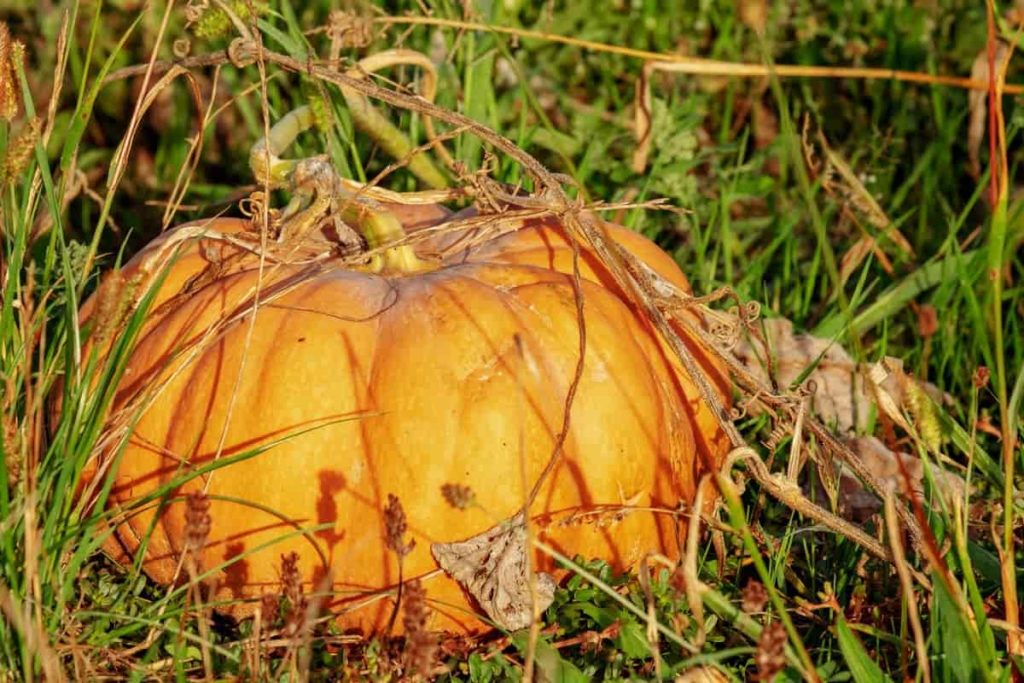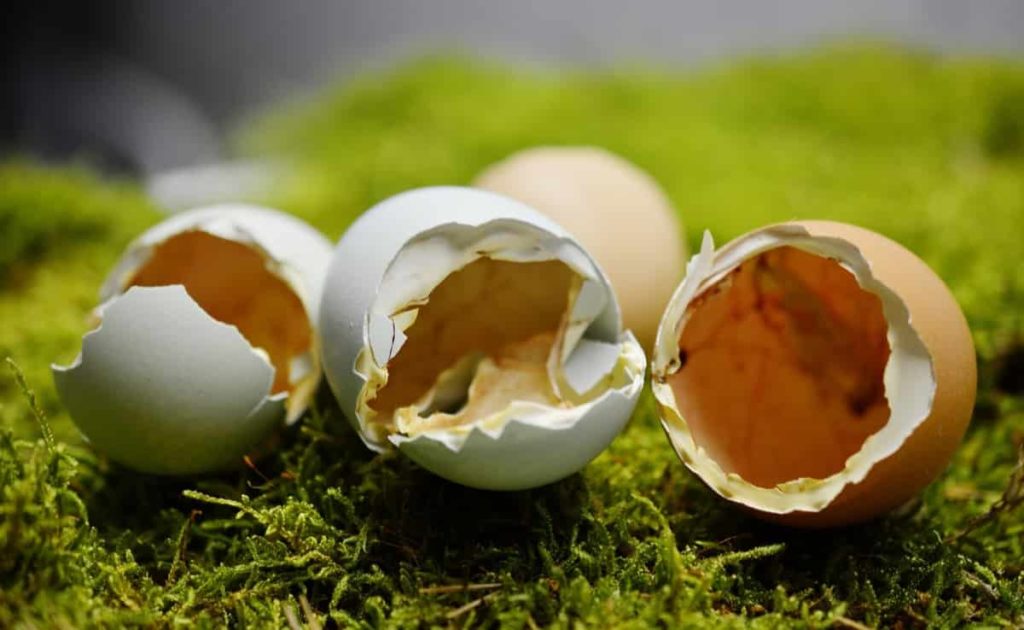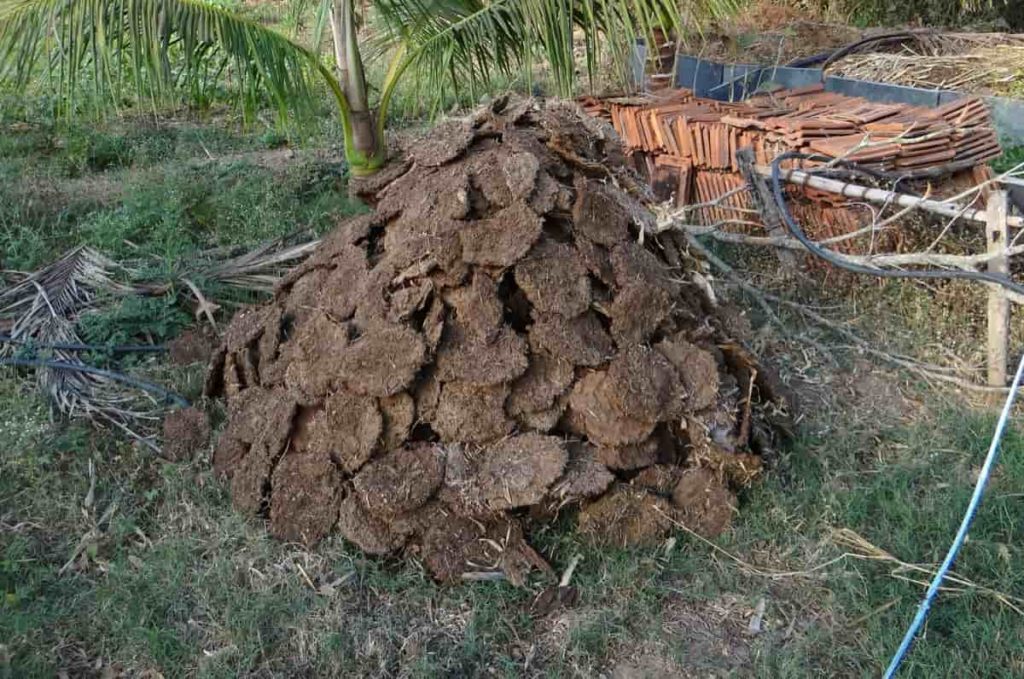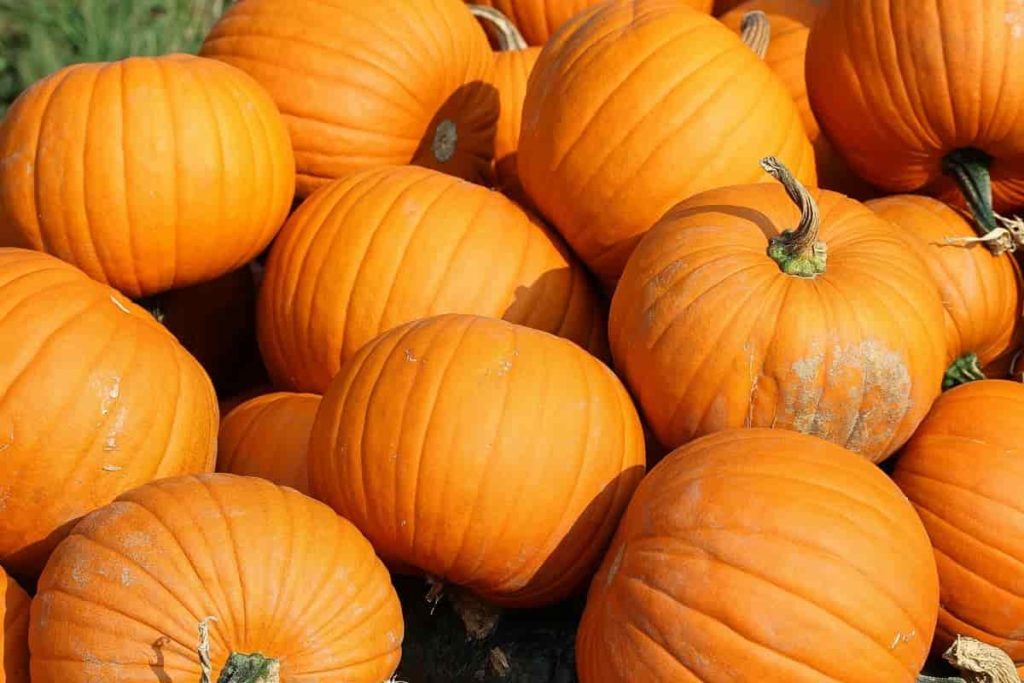The Pumpkin plant requires maintenance, attention, and plenty of soil nutrients. Consumption of fertilizers is very important as Pumpkins are heavy feeders. For various stages of its development, it will need a variety of fertilizers to help in the development of plants.

The total size of Pumpkin will tell you that they are thirsty plants and soil is needed with enough nutrients to produce healthy fruits. Soil may not contain enough natural nutrients and sometimes you need to use fertilizers to supply essential plant food. Let’s check out the best fertilizer for pumpkin
Nitrogen – Nitrogen is what is going to help your Pumpkin grow green, and should be added to the early growth stages. Nitrogen will help in the production of many strong vines and leaves which are essential for fruit growth. Excessive nitrogen burns Pumpkin roots and will cause more damage than good. Avoid adding fertilizer directly to leaves and vines.
Phosphorus – Once your Pumpkin plant starts to bear flowers; it is time to change from nitrogen-based fertilizer to phosphorus-based fertilizer. Phosphorus will help boost root growth, promote flowers and push your plants to start fruit development. You won’t have to worry about using too much phosphorus, just as you’ll need to do with nitrogen.
Potassium – Potassium is what is going to take your Pumpkin to this winning size. Once the fruit starts to set on the vines, you can switch to high phosphorus fertilizer. This will boost fruit growth and keep your plants happy and healthy. Apply too much potassium to start will make your plants grow very fast causing Pumpkins to burst.
Best fertilizer for Pumpkin
Liquid fertilizers for Pumpkin
Epsom salt
Prepare a foliar spray using Epsom salts for the Pumpkin. Mix 1 to 2 tablespoons of Epsom salt with 1 gallon of water until dissolved, then spray on leaves early in the morning.
In case you miss this: Pumpkin Gardening For Beginners, How To Start, FAQs

Compost tea
Add nitrogen-rich compost into a bucket to make compost tea, add a teaspoon of molasses, and fill the rest of the bucket with water. Stir every few hours to allow the bucket to air properly or place an aquarium pump in the bucket to keep it airy. After about 24 to 48 hours, strain the tea and use it for water around the plant as you usually water. Do this once a week in the vegetative stage.
Seaweed
Mix a teaspoon of the seaweed powder in a gallon of water and leave it to dissolve in the water overnight. The next day, water your Pumpkin and follow the same process once a week. This ensures that your plants have enough potassium to grow in meaty, large, delicious Pumpkins.
Homemade fertilizers for Pumpkin
Compost
The best way for your homemade fertilizer is to build two separate compost piles, one for the vegetative stage and one for the fruiting stage. Each pile should include most carbon, including leaves or other garden debris. Add nitrogen-rich ingredients to the botanical pile, including coffee grounds, manure, and kitchen scraps.
In case you miss this: Pumpkin Seed Germination, Time, Temperature, Process

Focus on potassium-rich ingredients such as banana peels and wood ash as well as phosphorus-rich ingredients such as grass clippings for the fruit pile. Fish emulation for nitrogen, bone meal for phosphorus, and kelp meal for potassium, add ingredients to the piles. To ensure your fertilizer is rotten enough to use for your Pumpkin, place it in a hot composting bin with a lot of air holes but enough to allow the fertilizer to heat fast. Turn piles every few days.
Vegetative Stage
Before you start or seed your Pumpkin in the ground, prepare the soil with enough nutrients because Pumpkins will be big feeders. Add nitrogen-rich manure into the hole where you will add plants. After planting, the side-dress each plant with some more manure and compost.
Fruiting stage
When you start seeing flowers grow, it’s time to switch to your homemade potassium and phosphorus heavy fertilizer. This fertilizer will continue to provide nitrogen, but now the focus will be more on the other two nutrients. It can be a sign of more fertility if your plants start to wither or the flowers stop growing. When this happens, skip a week and instead apply your compost tea every two weeks. Plants may lack magnesium if the leaves turn yellow or lime green between veins. You should use a foliar spray of Epsom salts sprays on leaves early in the morning.
Coffee grounds
Pumpkin likes to coffee grounds as nitrogen fertilizer, so be sure to keep adding it directly to the root zone in powder or liquid, or through ready-made fertilizer.
Eggshells
Pumpkins are heavy feeders. For soils less in calcium, crush or grind the eggshells and add them to the soil surface under the mulch at the base of each Pumpkin plant.
In case you miss this: Growing Pumpkins from Seed at Home – A Full Guide

Organic fertilizers for Pumpkin
Chicken manure
Adding nitrogen in the form of a cup of diluted urea or chicken manure should be mixed thin and well in 4 gallons of water (half a cup of fresh manure), followed by a seedling several inches tall about once or twice per month thereafter.
Fish emulation or seaweed
Fish emulation or seaweed extract is applied as a wet or foliar spray which can be beneficial in soil scarcity of infertile, alkaline, or micronutrients.
Bonemeal
You can increase phosphorus levels in the garden by adding bone meal fertilizer. Add bone meal fertilizer to the ground every 1 to 2 weeks as per its package instructions.
Compost manure for Pumpkin
Cow manure
Cow manure is an important component for Pumpkin growers when growing large Pumpkins. Adding 6 to 8 inch of cow manure to the fall and cultivating it in the soil helps in making important nutrients in the soil.
In case you miss this: Cow Manure For Plants – Composting, Benefits

Commercial fertilizers for Pumpkin
NPK ratio
A general-purpose balanced fertilizer with a ratio of 10-10-10 (NPK) fertilizer may not be sufficient for maximum growth of Pumpkin roots, seeds, stems, flowers, and fruits. As a start-up, 10-5-5 NPK will strongly support the formation and development of Pumpkin roots. Use nitrogen-heavy manure from at the beginning of the growing season to help it develop, but make sure you don’t apply it too close to the plant to prevent them from burning.
As flowers begin to form, turning into 5-10-10 NPK and supplementing with bone meal or rock phosphate will encourage the abundance of flowers. Finally, once the Pumpkin appears, eliminate the extra phosphorus and allow potassium to increase the size and formation of the Pumpkin. You can start by developing a good, well-drained soil in association with homemade fertilizer made from manure or well rotten manure a few weeks before planting.
Pumpkin fertilizer schedule
Three Stages of Pumpkin Fertilization
- Pre-flowering
- Flowering
- Fruiting
Pre-flowering
Before your vine starts to flower in the first 55 days or more, you need to make sure your plant has sufficient nitrogen. Nitrogen is an important factor for the early growth of a plant due to its chlorophyll mixture, a compound responsible for the plant’s green leaves, trunks, and vines. This compound absorbs energy from the sun after which it uses the plant to make sugars to feed (photosynthesis).
- When you check your soil, if you find out nitrogen is in deficit, add blood meal in the ratio 12-0-0 as per instructions on the package. Nitrogen helps young plants produce healthy and leafy green growth, leaves, and vines after they are fully established.
- If your soil test shows that other elements are also in deficit, apply a balanced ratio of 10-10-10 NPK fertilizer. Thus, meet your Pumpkin requirements for nitrogen and meet its heavy needs on phosphorus and potassium during its second and third growing stages.
- Feed your plant every 2 to 3 weeks until 10 to 15 days before flowering, and 40 to 45 days after germination.
Flowering
Your plant will start to produce blooms around 55 days after germination. During this phase, your plant will need phosphorus. This ingredient is necessary because it contains adenosine tri-phosphorate (ATP) that provides the plant with the energy it needs to make buds and fruits. If the plant lacks phosphorus, it will not bloom.
- Even if the plant bloom, its buds can abort before opening, and plants can abort pollinated fruits if they lack the energy to grow.
- Stop adding extra nitrogen about 40 to 45 days after it grows before flowering and start adding bone meal fertilizer instead.
- For best results, add bone meal fertilizer to the ground. Just keep an eye out for more fertilizing with phosphorus. You will know that if the leaves of the plant start turning yellow around its edges stop applying phosphorus.
- Once small fruits start producing on your plant vine, start focusing on increasing potassium in your fertilizer.
In case you miss this: Worm Composting – Indoors For Beginners

Fruiting
Don’t overuse phosphorus once your Pumpkins start growing, but make sure you’re giving them enough potassium. Potassium is also important in the case of ATP, as it helps regulate carbohydrates and water intake stored in your plant tissues.
- You can fertilize your Pumpkin in the ratio of 5-10-10 fertilizer which is high in both potassium and phosphorus. Alternatively, continue to consume plant bone meal and seaweed powder.
- If you see cracks in your Pumpkin, or if they are growing too fast, it is a sign of more fertilization with potassium. In this case, stop future potassium applications.
How to fertilize Pumpkin in pots
Buy a specially recommended commercial, bagged soilless mix for container growing. When filling your pot, mix the equal parts of this mix with the compost. Work the compost in half under the pot. If you are using homemade compost, press it to ensure you are not adding insects to your container. In the early stages of development, it is best to use balanced fertilizers like 10-10-10.
Switching to a low nitrogen fertilizer that is rich in potassium and phosphorus such as water-soluble 5-15-15 fertilizer every other week (when the plant has grown and is large enough to produce flowers) is a good idea. The reason to add compost is to improve the soil’s ability to hold water. You can also add a shovel of good garden loam to the container, with some water retention crystals. Both steps help maintain water in the soil, which your thirsty Pumpkin vine will appreciate.
The second reason for adding compost is to increase soil fertility. You should also mix the slow-release fertilizer into the soil before planting. Place the soil about two inches below the edge of the pot, and add a single layer of mulch to help damage the slow water loss from the soil.
Commonly asked questions about fertilizers for Pumpkin
Does sugar water help Pumpkins grow?
Feeding sugar to your Pumpkin can make them much bigger than just the sun and water. However, too much sugar can cause reverse osmosis, causing the plant to lose water and eventually die.
Does milk help Pumpkin?
Pumpkins need calcium and other micro-nutrients; it seems that it is not a brainer that growing Pumpkins with milk will increase their size.
Is urine Good for Pumpkin plants?
On the application of urine, Pumpkin, passion fruits, and cucumber showed good signs of growth. They also produce large-size fruits and vegetables due to the high nitrogen content in urine.
How much nitrogen does the Pumpkin need?
Approximately 35 to 45 kg nitrogen per acre is proposed. Higher rates can push the foliar growth at the cost of flowers and fruits.
- How to Grow Hibiscus from Flower
- Plantation Ideas for Home Decoration: A Beginners Guide
- Flower Garden Designs and Layouts for Beginners
- Planting and Spacing Techniques in Papaya: A Beginner’s Guide
- Growing Gold: Essential Techniques for Planting Pineapples
- How to Make Kalanchoe Plant Bushy: Home Remedies and Solutions
- 11 Reasons Why Your Gardenia is Not Blooming: Home Remedies and Solutions
- Eco Elegance: The Guide to Designing a Drought-Tolerant Landscape
- Gardening on a Slope: Strategies for Hillside Landscaping
- Nourish and Flourish: Top Organic Mulches for Thriving House Plants
- Everything You Want to Know about Indian Mogra Flower: Discover Uses and Growing
- Green Thumb Success: Expert Tips for Cultivating Greenhouse Pumpkins All Year Round
- Maximize Growth & Flavor: The Ultimate Guide to Companion Planting in Herb Gardens
- How to Control Rhododendron Problems Naturally: Home Remedies and Organic Ways to Fix Them
- Natural Magic: The Remarkable Benefits of Cinnamon for Plants
- Best Steps to Revive Dying Tulip with Natural and Organic Treatment
- 10 Reasons Why Your Angel Trumpet is Not Blooming: Remedies and Treatment
- How to Fix Periwinkle Leaf and Flower-Related Problems: Natural Remedies and Solutions
- How to Fix Zinnias Leaf and Flower Problems: Discover Natural and Home Remedies
- Organic Steps to Induce Lemon Tree Flowers: A Comprehensive Guide
- Bloom Booster: Crafting the Perfect Homemade Bougainvillea Fertilizer
- Optimizing Growth: A Guide to Applying NPK Fertilizer for Potted Plants
- 10 Best Homemade Fertilizers for Rubber Plant: DIY Recipes and Application Method
- How to Boost Female Pumpkin Flowers: Effective Steps for More Flowers and High Yields
- Transform Your Indoor Garden: Top Benefits of Pink Salt for Houseplants
- 10 Best Homemade Fertilizers for Peacock Plants (Calathea): Easy DIY Guide
- Unlock Blooms: 9 Reasons Why Your Potted Chrysanthemum is Not Blooming
- 8 Reasons Why Your Potted Hibiscus is Not Blooming: Fix it with Simple Solutions
- Unlock Blooms: 9 Key Reasons Your Potted Frangipani Won’t Flower
- 10 Reasons Why Is My Ice Plant Not Blooming: Remedies and Treatment
- 10 Reasons Why My Potted Hydrangea Not Blooming: Treatment and Remedies
- 10 Reasons Why is My Wisteria Not Blooming: Remedies and Treatment
- 10 Reasons Why is My Goldfish Plant Not Blooming: Remedies and Treatment
- Maximize Your Space: Ultimate Guide to Balcony Gardening with Grow Bags
- 10 Reasons Why Your Iris is Not Blooming: Remedies and Treatment
- 10 Reasons Why Your Anthurium Plant is Not Blooming: Treatment and Remedies